Related Research Articles

Sigma Tauri is the Bayer designation for a pair of white-hued stars in the zodiac constellation of Taurus. The system is a visual double star, whose components are designated σ1 Tauri and σ2 Tauri, with the latter being the more northerly star. The two are separated by 7.2 arcminutes on the sky and can be readily split with a pair of binoculars. They have apparent visual magnitudes of +5.07 and +4.70, respectively, which indicates they are both visible to the naked eye. Based upon parallax measurements, σ1 Tauri is about 147 light years from the Sun, while σ2 Tauri is 156 light years distant.
Rho Telescopii is the Bayer designation for an astrometric binary star system in the southern constellation of Telescopium. It is visible to the naked eye, with an apparent visual magnitude of +5.17. Based upon an annual parallax shift of 17.63 mas as measured from Earth, it is located approximately 185 light years from the Sun.
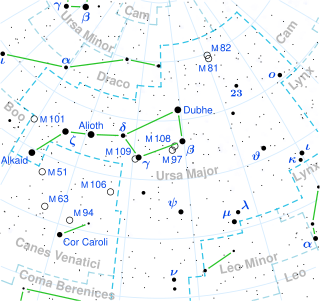
Omega Ursae Majoris is the Bayer designation for a binary star system in the northern circumpolar constellation of Ursa Major. It is visible to the naked eye with an apparent visual magnitude of 4.61. Based upon an annual parallax shift of 13.24 mas, it is roughly 246 light years from the Sun. At that distance, the visual magnitude of the star is diminished by an extinction factor of 0.11 due to interstellar dust.
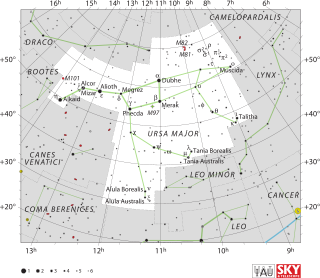
Tau Ursae Majoris (τ UMa) is the Bayer designation for a binary star in the northern circumpolar constellation of Ursa Major. It is visible to the naked eye, having an apparent visual magnitude of 4.66. With an annual parallax shift of 25.82 mas, it is located about 126 light years from the Sun. At that distance, the visual magnitude is diminished by an extinction factor of 0.19 due to interstellar dust.
Xi Cassiopeiae is a blue-white hued binary star system in the northern constellation of Cassiopeia. It has an apparent visual magnitude of +4.81 and thus is faintly visible to the naked eye. Based upon an annual parallax shift of 2.28 mas as seen from Earth, this system is located roughly 1,400 light years from the Sun. At that distance, the visual magnitude of the system is diminished by an extinction factor of 0.20 due to interstellar dust. It is advancing in the general direction of the Sun with a radial velocity of roughly −10.6 km/s.

Pi Cassiopeiae, Latinized from π Cassiopeiae, is a close binary star system in the constellation Cassiopeia. It is visible to the naked eye with an apparent visual magnitude of +4.949. Based upon an annual parallax shift of 18.63 mas as seen from Earth, this system is located about 175 light years from the Sun.
Delta Columbae is a binary star system in the constellation Columba. It can be seen with the naked eye having an apparent visual magnitude of 3.85. The distance to this system, based upon an annual parallax shift of 13.94 mas, is around 234 lightyears.

Xi Orionis is a binary star system in the northeastern part of the constellation of Orion, well above the red giant star Betelgeuse in the sky. It lies next to another blue main-sequence star, Nu Orionis, which is somewhat closer at 520 light-years' distance. The apparent visual magnitude of Xi Orionis is 4.47, which is bright enough to be seen with the naked eye. The distance to this star, as determined using the parallax method, is roughly 610 light-years.
Iota Coronae Borealis, Latinized from ι Coronae Borealis, is a binary star system in the constellation Corona Borealis. It is visible to the naked eye with a combined apparent visual magnitude of is 4.96. Based upon an annual parallax shift of 10.46 mas as seen from the Earth, it is located about 312 light years from the Sun.
Omega Eridani is a binary star system in the constellation Eridanus. It is visible to the naked eye with an apparent visual magnitude is 4.37. The distance to this star, as determined by the parallax method, is around 235 light years.

Tau9 Eridani is a binary star in the constellation Eridanus. It is visible to the naked eye with an apparent visual magnitude of 4.63. The distance to this system can be estimated using the parallax method, which yields a value of roughly 327 light years.
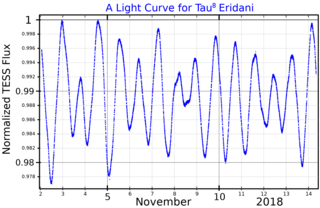
Tau8 Eridani, Latinized from τ8 Eridani, is a binary star system in the constellation Eridanus. It is visible to the naked eye with a combined apparent visual magnitude of 4.65. The distance to this system can be estimated via the parallax method, yielding a value of around 380 light years.
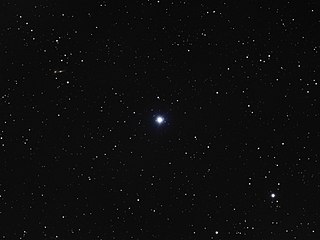
2 Lyncis is a binary star system in the northern constellation Lynx. It is visible to the naked eye, having an apparent visual magnitude of 4.44. The distance to this system, judging by an annual parallax shift of 20.83±0.40 mas, is around 157 light years. It is moving closer to the Sun with a heliocentric radial velocity of −2 km/s.

Pi2 Orionis (π2 Ori, π2 Orionis) is the Bayer designation for a solitary star in the equatorial constellation of Orion. Although the Bright Star Catalogue lists this as a spectroscopic binary star system, this does not appear to be the case. It is visible to the naked eye with an apparent visual magnitude of 4.35. Based upon an annual parallax shift of 14.53 mas, it is located roughly 224 light-years away from the Sun.

136 Tauri is a white-hued binary star system in the zodiac constellation of Taurus. It has a combined apparent visual magnitude of 4.56, which is bright enough to be faintly visible to the naked eye. Based upon an annual parallax shift of 7.71±0.22 mas as seen from Earth's orbit, it is located approximately 420 light years from the Sun. The system is moving nearer with a heliocentric radial velocity of −17.2 km/s, and is expected to make its closest approach in 6.5 million years at a distance of 150 ly (45 pc).
HD 85622 is a binary star system in the southern constellation of Vela. It is visible to the naked eye with an apparent visual magnitude of 4.58. The distance to HD 85622 can be estimated from its annual parallax shift of 4.3 mas, yielding a value of 750 light years. It is moving further from the Earth with a heliocentric radial velocity of +8 km/s.

Xi1 Lupi (ξ1 Lup, ξ1 Lupi) is a probable binary star in the southern constellation of Lupus. It is faintly visible to the naked eye with an apparent visual magnitude of 5.1, and forms a visual double star with Xi2 Lupi. Based upon an annual parallax shift of 23.60 mas as seen from Earth, it is located around 140 light-years from the Sun. It is a member of the Upper Scorpius sub-group of the nearby Sco OB2 association.

42 Persei is a binary star system in the northern constellation of Perseus. It has the Bayer designation n Persei, while 42 Persei is the Flamsteed designation. The system is visible to the naked eye as a dim, white-hued point of light with an apparent visual magnitude of 5.11. It is located around 93 parsecs (302 ly) distant from the Sun, but is drifting closer with a radial velocity of −12.4 km/s.

55 Persei is a single, blue-white hued star in the northern constellation Perseus. It is faintly visible to the naked eye under good seeing conditions, having an apparent visual magnitude of 5.73. Based upon an annual parallax shift of 8.50±0.38 mas as seen from Earth's orbit, the star is located about 380 light years from the Sun. At that distance, the visual magnitude is diminished by an extinction of 0.39 due to interstellar dust.
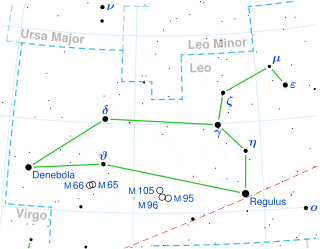
ν Leonis, Latinised as Nu Leonis, is a binary star system in the zodiac constellation of Leo. It is faintly visible to the naked eye with an apparent visual magnitude of 5.15; parallax measurements indicate it is around 500 light years away. At this distance, the visual extinction from interstellar dust is 0.33 magnitudes.
References
- 1 2 3 4 5 6 van Leeuwen, F. (2007), "Validation of the new Hipparcos reduction", Astronomy and Astrophysics, 474 (2): 653–664, arXiv: 0708.1752 , Bibcode:2007A&A...474..653V, doi:10.1051/0004-6361:20078357, S2CID 18759600.
- 1 2 3 4 Anderson, E.; Francis, Ch. (2012), "XHIP: An extended hipparcos compilation", Astronomy Letters, 38 (5): 331, arXiv: 1108.4971 , Bibcode:2012AstL...38..331A, doi:10.1134/S1063773712050015, S2CID 119257644.
- 1 2 3 4 Morrell, Nidia; Abt, Helmut A. (July 10, 1992), "Spectroscopic binaries in the Alpha Persei cluster", Astrophysical Journal, Part 1, 393 (2): 666–673, Bibcode:1992ApJ...393..666M, doi:10.1086/171534.
- ↑ de Bruijne, J. H. J.; Eilers, A.-C. (October 2012), "Radial velocities for the HIPPARCOS-Gaia Hundred-Thousand-Proper-Motion project", Astronomy & Astrophysics, 546: 14, arXiv: 1208.3048 , Bibcode:2012A&A...546A..61D, doi:10.1051/0004-6361/201219219, S2CID 59451347, A61.
- 1 2 3 4 5 6 Zorec, J.; Royer, F. (2012), "Rotational velocities of A-type stars. IV. Evolution of rotational velocities", Astronomy & Astrophysics, 537: A120, arXiv: 1201.2052 , Bibcode:2012A&A...537A.120Z, doi:10.1051/0004-6361/201117691, S2CID 55586789.
- 1 2 McDonald, I.; et al. (2012), "Fundamental parameters and infrared excesses of Hipparcos stars", Monthly Notices of the Royal Astronomical Society, 427 (1): 343–357, arXiv: 1208.2037 , Bibcode:2012MNRAS.427..343M, doi: 10.1111/j.1365-2966.2012.21873.x , S2CID 118665352.
- ↑ "30 Per". SIMBAD . Centre de données astronomiques de Strasbourg . Retrieved 2018-03-08.
- ↑ Hoogerwerf, Ronnie (March 2000), "OB association members in the ACT and TRC catalogues", Monthly Notices of the Royal Astronomical Society, 313 (1): 43–65, Bibcode:2000MNRAS.313...43H, doi: 10.1046/j.1365-8711.2000.03192.x